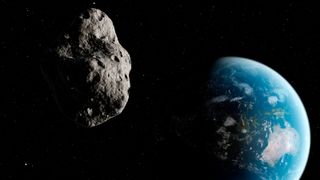2,000-foot-wide 'potentially hazardous' asteroid has just made its closest approach to Earth — and you can see it with a telescope
The 2,000-foot-wide asteroid 2013 NK4 just made its closest approach to Earth in recorded history, sailing by at about eight lunar distances. You can still see the massive rock with a backyard telescope.

A "city-killer" asteroid has just made its closest approach to Earth since records began, sailing safely past our planet at more than eight times the average distance between Earth and the moon. Despite being classified as "potentially hazardous," the gigantic space rock poses no threat to our planet. But for the first time ever, it will be visible via amateur telescopes over the next three nights (April 15 - April 17).
The hefty asteroid, named 2013 NK4, is around 2,000 feet (610 meters) wide, making it about twice the size of the "god of chaos" asteroid Apophis, which will make a superclose approach to Earth in 2029, EarthSky reported.
The space rock made its closest approach to Earth at 10:50 a.m. EDT Monday (April 15), when it reached around 2 million miles (3.2 million kilometers) from our planet, according to NASA's Jet Propulsion Laboratory (JPL). At the time, it was traveling at around 37,000 mph (59,000 km/h).
The asteroid is big enough to destroy a large city and cause serious environmental impacts if it were to smash into Earth. According to NASA's calculations, the space rock will likely never get anywhere near impacting Earth. However, due to its size and proximity to our planet, it is still considered a potentially hazardous asteroid.
While the asteroid poses no threat to Earth, its close approach is still of great interest to astronomers, who are currently tracking the space rock with radio telescopes. They hope to capture specialized radar images, known as delay-Doppler images, which should help shed more light on the asteroid's size and shape.
Related: 'Planet killer' asteroids are hiding in the sun's glare. Can we stop them in time?

But you don't have to be a professional astronomer to take a peek at this space rock. The asteroid will be visible to anyone with a decent astronomy telescope until April 17. However, due to its orientation relative to Earth, the asteroid will be most clearly visible on April 16 and April 17, according to EarthSky. You can find out where it will be in the sky by using TheSkyLive.com.
Sign up for the Live Science daily newsletter now
Get the world’s most fascinating discoveries delivered straight to your inbox.
2013 NK4 orbits the sun every 378 days on an elliptical orbit, according to EarthSky.com.
Since it was first discovered in 2013, the asteroid has made 11 close approaches to our planet and will return for another, more distant flyby on April 23, 2025, according to the JPL Small-Body Database. However, 2013 NK4 has never been spotted close enough to be seen with a backyard telescope.
Simulations of the asteroid's trajectory, which retraced the space rock's orbit around the sun as far back as 1900, also show that this is the asteroid's closest approach in at least 125 years. However, the same simulations show that it will make an even closer approach to Earth in 2055, when it will reach a minimum distance of around 1.3 million miles (2.1 million km) from our planet — or less than six times the average distance between Earth and the moon.
So, if you want to see this gigantic space rock for yourself, make sure to head outside over the next few nights. Cross your fingers for clear skies, because you won't get another chance to spot it for more than 30 years.

Harry is a U.K.-based senior staff writer at Live Science. He studied marine biology at the University of Exeter before training to become a journalist. He covers a wide range of topics including space exploration, planetary science, space weather, climate change, animal behavior, evolution and paleontology. His feature on the upcoming solar maximum was shortlisted in the "top scoop" category at the National Council for the Training of Journalists (NCTJ) Awards for Excellence in 2023.
-
thunderbolt As this is a science site, could you please use the metric system in your articles. This is an article about space. Scientists that study space use the metric system.Reply -
GreatGooglyMoogly Couldn't agree more on the suggestion to use the modern metric system. Nothing is more cringeworthy IMHO than a science site, or science related program using arcane and folksy units of measure in the 21st century, on a metric planet save for one intransigent nation.Reply
